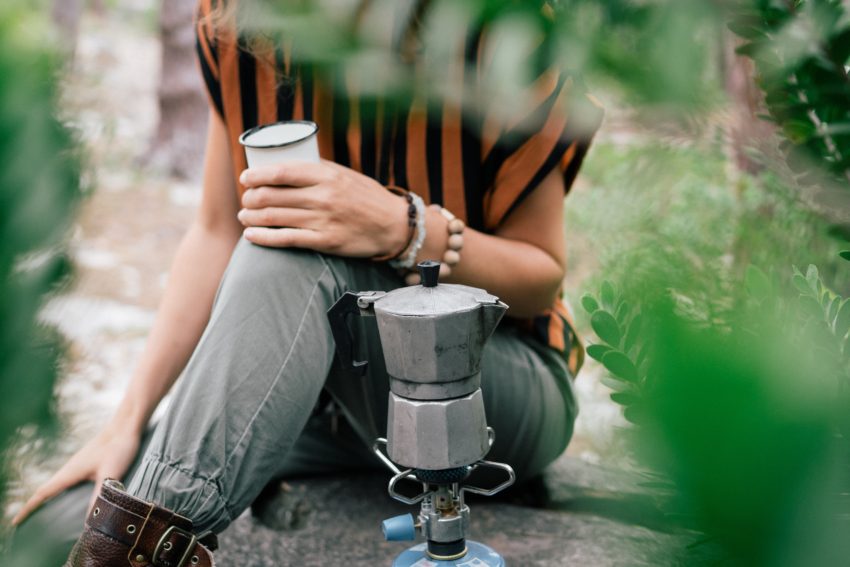* We use affiliate links and may receive a small commission on purchases you make.
Best Stoves for Camping & Hiking
Portable stoves differ widely in their size and portability.
The smallest models are usually known as backpacking stoves and are designed to be small and lightweight due to their common use in hiking, backpacking or cycle touring.
These stoves generally have a burner, fuel tank and pot supports.
Some of them use solid or liquid fuel placed in the burner before lighting and others use fuel in a pressurised burner, gas bottle or gravity-fed system.
Camping stoves on the other hand are designed for use by people travelling by car, camper, boat, canoe, or on horseback so tend to be bulkier in nature.
They often have two burners set into a table-like surface, have flaps for wind protection while cooking, and a folding lid for tidy stowage.
Below we break down the top stoves of 2020 for camping and hiking including leading gas, liquid fuel and wood burning models.
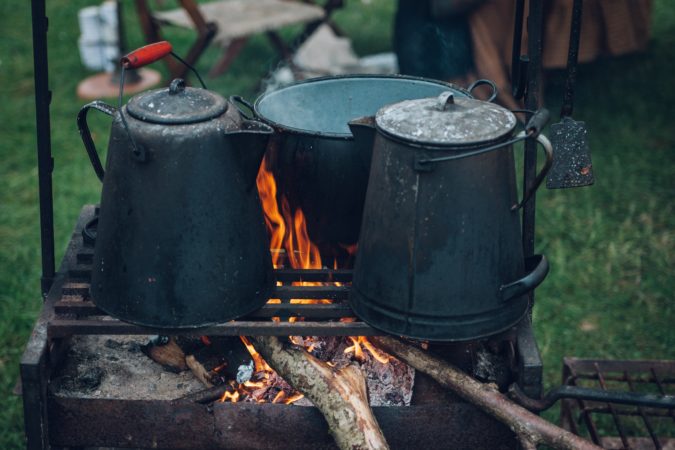
Terms You Need to Know
BTUs – British Thermal Units are the traditional unit that measures the heat given off by a gas burner. One BTU will raise the heat of one pound of water by one degree Fahrenheit. Most stoves specify their heat output in BTUs. One watt = 3.4 BTUs per hour.
Liquid Fuels – Alcohols – methanol, ethanol, propanol, and butanol – all have a high octane rating = increased fuel efficiency = economical. Petrol/ gasoline are other liquid fuels.
Piezo – A push buttom igniter with an electric spark that lights the stove.
Types of Cooking Stove Fuel
Gas & Liquid & Solid
Propane, butane, isobutane, kerosene, alcohol, white gas, gasoline and solid fuels are the main cooking stove fuels for those hiking or camping.
I’ve created a free PDF table of all these fuels. It includes all the main fuels, their pros and cons plus I’ve included the other names they’re are known by so you’ll never be left without again, wherever you are in the world.
You can download it to your phone or print so you’ll have it wherever you need it. Grab your free download below.
The form you have selected does not exist.
Camping Fuels in Order of Cost-Effectiveness: (Taking packaging into consideration)
- Gasoline
- Propane
- Kerosene
- White Gas
- Alcohol
- Butane/Isobutane canisters
Fuels ranked by easiest to find near you:
- Petrol/ Gasoline
- Propane
- White Gas
- Alcohol
- Kerosene
- Butane/Isobutane
If you’re travelling worldwide some fuels can be harder to find so pick a fuel type that is readily available in the countries you’re travelling to and go with a stove that burns that.
The MSR Whisperlite, for example, is versatile as it can run on fuels available almost everywhere – white gas, kersosene and unleaded petrol.
Or you could go with a methylated spirit burner like the Trangia or a canister stove as the cartridges are increasingly widely sold.
Paint, hardware stores and pharmacies may be places to look if you’re struggling to find the fuel you need in a given country.
Good places to search for fuel canisters (butane & isobutane) or bottles (propane/LPG) are in larger towns, sporting, hunting or hardware stores or at petrol stations.
Types of Stoves 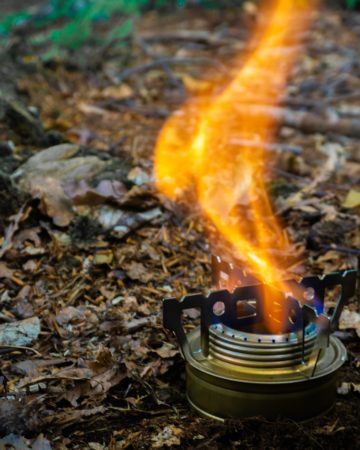
Here are the main types of camping stove:
- un-pressurised liquid fuel camping stoves
- pressurised liquid fuel camping stoves
- solid fuel-burning camping stoves – man-made tablets
- solid fuel-burning camping stoves – wood & debris burning
Want Suggestions Now?
Gas Multi-Burner Stove (vehicle camping): Coleman Propane 3-Burner or Coleman 2-Burner Stove
Hiking Canister Stove: Jet Boil Cooking System or MSR PocketRocket 2
Hiking Liquid Fuel/ Gas Stove: MSR WhisperLite Universal Canister and Liquid Fuel Stove or Esbit Alcohol Cooking Set or Trangia Burner Set
Liquid Fuel Camping Stoves
-
Unpressurised Liquid Fuel Camping Stoves
The simplest kind of stove is a single burner design where the burner contains fuel which burns until it is put or runs out.
These are either liquid or solid fuel stoves and are often used where mass and bulk are a priority.
Single Burner Alcohol Stoves
These stoves run on liquid fuel under no pressure. They’re ultralight, affordable and simple. They can’t compete with liquid or canister stoves for heat output and flame control but for overall weight and ease of finding fuel, you’d be pressed to beat them.
The Trangia Stove is a popular alcohol stove that often comes with a sealing lid so it can be transported still containing fuel.
Don’t put on the lid while it’s hot though as this can damage the seal, causing fuel leakage in transit.
The Trangia burner runs on Tenol or methylated spirits which are low cost, safe and readily available.
You can also buy a version with a wind shield.
Trangia Spirit Burner With Lid – 110g/0.24lbs
- Packed Dimensions: 2.85″ x 1.75″
- Output: 1000 w/ 3500 BTU
- Boil Time: 10 min for 1 litre
- Fuel Type: Alcohol
- Fuel Options Worldwide – Tenol eller T-röd (SE), Methylated spirits or bioethanol spirit (UK), Brennspiritus (D), Ethyl alcohol or Denature alcohol (USA), Methyl alcohol or Wood alcohol (AU), Alcool a brûleur (FR), Rødsprit (N & DK), Gedenatureerde alcohol (brandspiritus) (NL), Marinol-100 or Sinol (FI).
Pro: Simple construction, easy to use, cheap fuel and works in all weather conditions.
Con: One filling (max. 2/3 of its height) will burn in approx. 25 min so requires refilling if cooking longer than that.
Tip: Allow generally 1 litre of methylated spirits for cooking for 2 people per week. Never refill the spirit burner until the flame is completely extinguished.
Wicking Stoves
Wicking stoves are typically fuelled by alcohol or kerosene. A great example of this is the CleanCook Stove.
Made by Dometic AB in Sweden. 1 L of fuel per day will provide cooking for a group of 5.
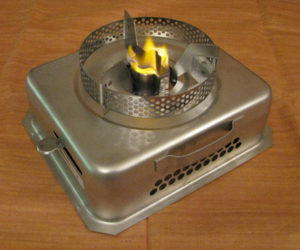
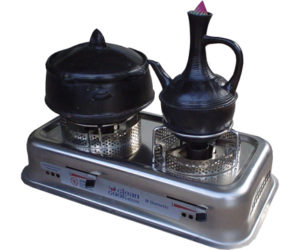
Pro: It’s stable, made of stainless steel/ galvanised steel/ aluminium and has one (Nova 1) or two (Nova 2) burner options. Negligible soot.
Con: Canister filled with 1L ethanol – must wipe any drops away from hole. Match/lighter ignition.
Tip: Recommended water content in fuel is less than 10%.
-
Pressurised Liquid Fuel Camping Stoves
Compact Hiking & Camping Stoves
These stoves run on fuel under pressure from either a refillable bottle or canister.
They include ‘white gas’ and stoves by MSR where priming pressurises the fuel tank and pre-heats the burner.
Pressurised burner stoves can burn several different fuels including alcohol, gasoline or other motor fuels, kerosene, and jet propellant.
Little or no modification is needed but the jets of multi-fuel stoves may need to be changed for the different fuels.
The very popular MSR WhisperLite International is a versatile option as it can run on white gas, kerosene and unleaded fuel while the MSR Universal stove can run on those and be adapted to run on canisters too. The Universal also simmers well.
MSR WhisperLite
MSR WhisperLite Universal Canister and Liquid Fuel Stove – 423g
- Superior Cold Weather Performance
- More economical fuel cost over time
- Works with canister fuel, white gas, kerosene and unleaded petrol/gasoline
- Includes: Fuel pump, windscreen, heat reflector, small-parts kit, instructions, and stuff sack.
Pro: They are light and great in cold or adverse weather conditions. Switches easily over to liquid fuels for longer trips, for use in cold-weather, and internationally.
Con: The fuel tank is not self pressurising so needs to be periodically pumped to maintain pressure to the burner.
Tip: Buy a MSR fuel bottle too as it isn’t included when you buy the stove. They’re airtight and allow fuel to be stored longer and reduce chance of spillage.
Good to know:
MSR recommends 4 oz. (115ml) of liquid fuel per person per day for cooking or 8 oz. (237ml) of liquid fuel per person per day for melting snow and cooking.
At high altitude, MSR stoves may burn “rich,” which hinders vaporisation. Reducing fuel bottle pressure and opening up the windscreen can offset this.
Gas Cartridge Stoves
Portable gas burner stoves use cartridges that contain liquefied gas held under pressure – butane, propane or a mixture of hydrocarbons.
No priming is required as the liquid vaporises as it leaves the cartridge/ container and arrives at the burner as a gas.
Usually these stoves either sit on a canister or have the cartridge joined to the burner by a pipe.
While these stoves are usually very compact and easy to use, the weight comes in carrying the fuel for them in canister form so if you’re on longer hikes, opt for a liquid fuel one instead. For short trips though, canister models are hard to beat.
They also don’t work well in cold conditions and fuel costs work out more expensive than liquid fuel stoves. In addition, the canisters are not always easy to find overseas, can’t be taken on flights and are not refillable so they get sent to landfill after use.
MSR Compact Stove
MSR PocketRocket Stove – 85g
- Palm-sized dimensions
- No need for priming
- Boils 1 litre of water in under 3.5 minutes.
- Burn time – 60 mins on 8 oz canister
Pro: Super convenient. Lightweight. Compact. Simmers well.
Con: Canister availability and weight. Empty canisters go to landfill.
Tip: Glove friendly controls allow you to adjust the flame precisely so you can simmer or boil.
Alternative: Soto Amicus (81g) with stealth igniter. It’s low cost for high-end performance and is compatible with Primus, Snow Peak, MSR and Jetboil canisters. You can read a gear test for it here.
Coleman Portable Butane Stove
If you’re travelling by vehicle and have more space then a bigger stove may be more suitable as they tend to be less top heavy.
The Coleman Portable runs on disposable butane cartridges.
Coleman Portable Butane Stove & Carry Case – 2kg
- SIZE 20 x 12 x 4″
- Matchless lighting
- 7,650 total BTUs of adjustable cooking power
- Fits up to a 10 inch pan
- Lasts up to 1.25 hours on high on one 8 oz butane gas cylinder
- Easy to clean & aluminum burner is rust proof
- Carry case included
Pro: Convenient. High heat output and easily adjustable. Large, stable base.
Con: Perform poorly in cold weather. Gas cartridges sold separately and tend to be costly and add to landfill as canisters are not refillable usually.
Tip: Buy canisters in bulk as this can sometimes save you money and means you’re unlikely to be left without fuel even if you are staying out in the whops.
Jetboil Flash
A stove worth highlighting here is the Jetboil cooker. The Flash version boils 1L of water in a mere 100 seconds.
These have integrated systems which means they have a burner, heat exchanger, canister and pot that fit together in one package.
They’re very efficient, heating more with less fuel. Even the standard Jetboil can boil 0.8L in just over 2.5 minutes. I’ve seen it in action on the Rakiura Track and it’s pretty impressive both in sound and speed.
It has a 1L cooking cup with insulating cozy so makes boiling water—and keeping it warm—a breeze. It’s equipped with a push-button igniter and you know when your water’s done because it has a thermo-chromatic colour-change heat indicator on the side of the cozy.
The bottom cup also doubles as a measuring cup and bowl so this stove is easy to pack up and lightweight and would be a clear choice if all you want to do is boil water for hot drinks or dehydrated meals. The Jetboil MiniMo is worth a look if you want more cooking potential and simmer control.
Jetboil Flash Camping Stove System – 393g
- A compact and efficient stove
- Includes fuel canister stabilisers
- You can buy Jetboil accessories, such as a coffee press, hanging kit, pot support, skillet, FluxRing cooking pot, canisters and utensils.
Pro: Boils water super fast with half the fuel consumption of traditional systems. Built for that purpose and great at it. You get all you need in one purchase. Push button start. Great stability and wind resistance.
Con: Price. Great at water boiling – cooking in them, not so much – they’re a bit ‘one trick pony’. Hard to use a different pot with it.
Tip: If you want to try cooking food on it, heat on LOW and watch it. Even with the special pans flux rings, you have to be super careful not to burn whatever you are cooking.
Multiple Burner Stoves
Multiple Burners are stoves with two or more burners that can be used together. They usually have a suitcase construction and are meant to be used on flat, stable surfaces.
These are ideal where space and weight are less of an issue and are commonly used in vehicle camping situations.
They most often have a single tank that’s shared by all burners and typically burn compressed gas, alcohol or white gas/ Coleman fuel.
Coleman 2 Burner Propane Stove
Coleman Gas Camping Stove Classic Propane Stove, 2 Burner – 5.4kgs
- SIZE 4.1 x 21.9 x 13.7″
- Aluminium & steel body
- Up to 20,000 total BTUs
- Windshield for burners
- Runs for up to 1 hour on high on one 16 oz. propane cylinder
Pro: Two adjustable burners for precise temperature control & pressure control technology keeps the heat steady for consistent performance, even in cold weather, high altitudes, or when fuel is low.
Con: Only one hour of cooking per 16 oz. propane canister.
Tip: Fuel sold separately.
Camp Chef Everest 2 Burner Stove
Camp Chef Everest Stove – 5.4kgs
- Size – 13.5″ L x 23.5″ W x 4″ H
- Two powerful 20,000 BTU burners that fight windy conditions – 40,000 BTU/hr
- Three-sided wind barrier
- Matchless ignition (piezo)
- Stainless steel drip tray for easy clean up
Pro: Two adjustable burners for precise temperature control. Regulator adaptor for a 1-lb. propane cylinder included but can be adapted for use with a standard bulk propane tank using a 5-ft bulk tank hose adapter.
Con: Only one hour of cooking per 16 oz. propane canister.
Tip: Fuel sold separately.
Solid Fuel-Burning Camping Stoves
Manufactured fuel
These cookers are simple yet effective. You can get started here with little more than a folding stand with legs and a few tablets of fuel (hexamine or trioxane).
They are raised off the ground to make them safer in terms of fire risk and the legs provide support for pots.
They weigh next to nothing but the tabs don’t burn as hot as other fuel types and cooking over them leaves a sticky, black mess on pot bottoms.
Esbit Ultralight Folding Pocket Stove with Solid Fuel Tablets – 180g incl fuel
- Constructed from galvanised steel
- Includes 6 smokeless, Esbit 14 g solid fuel tablets – each one burns for approximately 12 minutes
- Small – 3.9 inch x 3 inch x 0.9 inch or 9.8 cm x 7.7 cm x 2.3 cm
Pro: Simple, stable and compact. Esbit tablets will burn at any temperature or altitude and are included with stove purchase. Two cooking positions – suitable for cups, pots, and pans.
Con: Takes 8 minutes to boil half a litre of water so it’s no Jetboil for speed, though it is smaller. Smells a bit and blacks pots. When fire restrictions are in effect stoves like this are often not allowed as they have no shutoff switch.
Tip: You can snuff out a cube when it’s half used for use at a later time. Esbit can be shipped via surface but not taken on planes or boats in the USA and may take longer to boil at high altitudes or in high winds. Tablets are toxic if ingested.
Natural fuel – wood & debris
The advantage of these stoves if that you don’t need to carry any fuel with you as they cook using wood, leaves and other debris like pine cones, which are usually easy enough to find.
Given that you don’t need to carry additional fuel, these stoves are great for long trips as you can collect your fuel as you go.
If you love actual fires and don’t mind slower cooking, go for one of these, but remember that your pots will end up blackened by soot and fire regulations may mean you can’t use one in places at certain times of the year.
Solo Stove Lite – Portable for Camping/Hiking/Survival
- Features a unique double wall that allows fuel to burn more completely and with less smoke.
- Boils water in 8-10 mines (34 flu oz. water).
- Made of premium stainless steel and chrome wire.
- Nylon stuff sack included.
- Compact design – nests inside the companion Solo Stove Pot 900 (not included).
Pro: Fuel is free! Can’t beat that. Lightweight and a fast boil time. Compact and weighs only 9 oz/ 250g. No leaks or stove flaring.
Con: When fire restrictions are in effect, wood fires, including twig stoves like this, are not allowed. Burn rate is only controlled by varying the amount of fuel placed in stove. Solid fuel releases less heat gram for gram. Wood is not a clean burning fuel so cookware gets sooty. Wood may be wet at times, making fire starting trickier.
Tip: Any dry twigs, pinecones or leaves will burn but for optimum efficiency the manufacturers recommend use of dry hard woods (broad leafed – like Eucalyptus & fruit tree wood).
Esbit Alcohol & Solid Fuel Stove Set
This stove set provides you with two fuel options – tablets & alcohol. It includes an almost 985ml pot, a 470ml pot which serves as a lid too, a stand, a base for the fuel tablets, and a solid brass alcohol burner which has variable temperature control.
 Esbit Trekking Cook Set – 417g/14.7 oz.
Esbit Trekking Cook Set – 417g/14.7 oz.
- Constructed from light, anodised aluminium
- Both cook pots are equipped with two, lightweight, hinged grips made of stainless steel.
- Brass alcohol burner has a screw top and rubber gasket so can seal to store fuel.
- When packed: 5.8″ x 5.0″ (14.7 cm x 12.7 cm)
Pro: Everything stored and carried in the large pot, which comes with a mesh bag, and fits compactly in your backpack.
Con: Doesn’t include a fuel bottle but a small amount can be stored in the alcohol burner until it’s needed. Messy when using solid fuel. Requires refuelling for longer cook times.
Tip: Fuel sold separately.
Deciding On The Best Stove For You
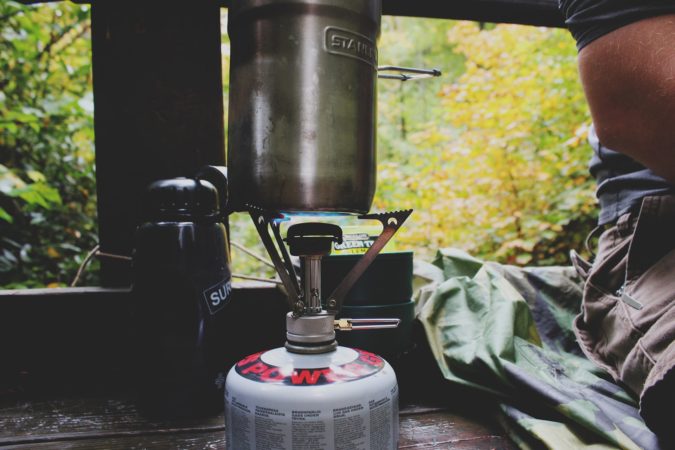
What Are Your Needs?
When choosing which stove to go for, you’ll want to consider your group size, use convenience, space & weight, speed of cooking, durability and cold weather performance.
You’ll have to prioritise so ask yourself some questions like those below.
Is weight or space paramount to you?
Are you hiking in high altitudes or not?
Do you want flame control or just to boil water?
Do you want to watch your stove or be free to kick back while it heats?
Group Size
If you’re going hiking alone or with another preson probably a standard gas canister burner like the For vehicle camping groups of 1-3, single burners like the Gas One GS-3000 or the Coleman Portable maybe all you need.
For groups of 4, a 2 burner like the Camp Chef Everest or the Coleman 2 Burner Propane Stove. They’ll fit into your vehicle easily as they’re compact and will give enough cooking power. You can even get a tank hose adaptor so you can use a larger propane tank instead of the 10 oz canister and that’ll be money saving right there.
Space & Weight
While it’s hard to compare hiking stoves on weight due to varying fuel requirements, in general you can expect alternative fuel stoves to be lightest and liquid fuel ones to be heaviest while canister stoves sit in the middle. If minimising space and weight are your focus, then Trangia or Esbit style burners are hard to beat.
If weight isn’t such a concern to you, the Coleman Dual Fuel is a sturdy, reliable cooker that runs on both unleaded petrol/ gas and Coleman Fuel (white gas).
If you’re camping with a vehicle, weight is probably less of an issue. A convenient multi-burner like Coleman’s Propane 2 Burner or a stable Double Burner Iron Camping Stove is likely a more suitable choice.
If you’re trying to conserve space though, and have the extra money, the fold up 2 burner Jetboil Genesis could be just what you’re looking for.
Cookware
Titanium – In terms of cookware, titanium pots like the MSR Big Titan are lightest and stronger than aluminium options, though carry higher price tags and develop hot spots so may burn in places.
Anodised aluminium – Less expensive than titanium. Lightweight. Efficient so saves fuel. Conducts heat evenly. Easy to clean with non-stick coating. If you want to cook meals with fresh ingredients or temperature sensitive ones like eggs, go with this metal.
Stainless – Very durable. While stainless is the least light of these three metals, it’s the toughest and scratch resistant. However, it does not conduct heat very well, which can lead to hot spots and burned food, so keep an eye on your pot when cooking. To mitigate this you could buy a pan or pot with an aluminium or copper base like these or just a regular bush pot with a lid.
Tip: According to MSR, pots with darker bottoms tend to be more fuel efficient so older, blackened pots become more efficient than new cookware as the heat transfers faster.
Wind Protection
Wind and flame based stoves don’t get along as it can mean the need to reignite, a hassle in very windy conditions.
If you’ll be heading into stormy or elevated regions, stoves that are integrated leave little of the stove exposed to wind while other types of stoves will benefit from the use of windscreens or require cooking in well-protected zones instead of exposed ones.
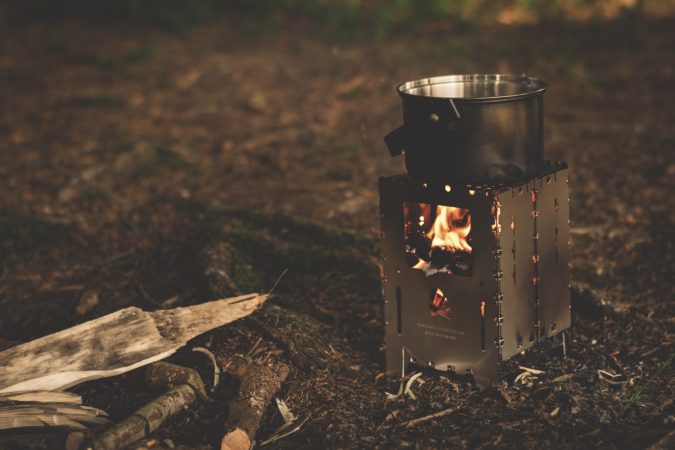
Altitude & Temperature
High altitude and cold conditions both affect stove performance, meaning slower cooking times. Ironically, you also get more dehydrated at high altitudes so you should boil more water to drink.
If you’re heading into these conditions for extended times, I’d recommend you get a liquid fuel stove over a canister one as the canisters can depressurise and have weak flames up high.
However, if you love the convenience of canister stoves and also want to head into mountainous areas, consider the MSR WhisperLite Universal, which can allow you to adapt to canister use, invert the canister and also works on white gas, kerosene and unleaded gas.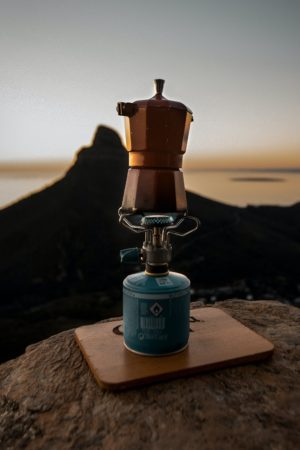
The alternative is sticking your cold canister inside your jacket or sleeping bag to warm it up before use in high altitudes.
Bear in mind that when temperatures soar however, the use of solid or liquid fuel stoves may not be allowed during total fire ban days, so stoves like Esbit are not OK to use on these days in Australia, for example, while gas stoves are.
So before you buy a stove just consider if the place and time of year you camp or hike most is going to be a deciding factor for you.
Piezo or not
Piezo igniters are so handy and save time looking for matches or lighters. They are awesome in windy conditions when other lighters get blown out.
On the down side, these built in switches make units a little heavier and sometimes they fail, so be sure to take back up lighters anyway.
International Travel
If you’re travelling through multiple countries you’ll want a stove that runs on fuels that are readily available in those places.
White gas and canisters are not sold everywhere but multi-fuel stoves run on fuels that are almost ubiquitous so research your destinations to find out what fuels are easy to get hold of in the places you’re going to and what they’re called as names vary across the world.
Also, airline restrictions mean you can’t carry fuel on planes so know where to find fuel refills when you arrive.
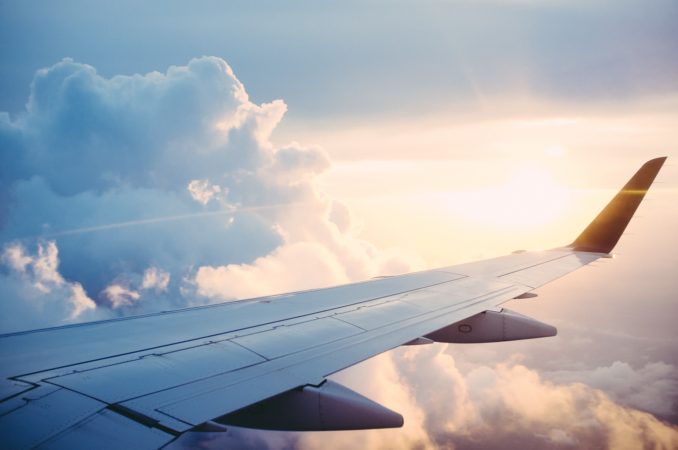
A Bit Of History
People around the world cook in different ways based on factors like culture, time period or fuel availability.
To date they’ve used one of the following cooking energies:
- solid biomass – wood, dung, briquettes, pellets or charcoal.
- solid coal
- solar
- electricity liquid – ethanol, kerosene, oils
- gas – LPG, natural gas, biogas or woodgas
The use of lightweight portable stoves for camping became commonplace in Britain and Europe in the latter half of the 19th Century and later in North America.
Before that, open fires were mostly used but impacted the environment by spoiling natural areas with fire scars and other unsightly damage.
Single burner alcohol stoves similar to modern Trangias hail back to the early 1900s.
Many boats in these early days used alcohol based stoves over kerosene versions for safety reasons, while military stoves like the WWII Pocket Stove ran on gasoline.
Nowadays, compressed gas versions use LPG, butane or propane fuels to provide a wide range of alternatives. Some modern stoves are even able to burn multiple types of fuel, which makes them well suited for international travel where fuel availability may vary.
Summary
I hope this information will help you to select the best backpacking, camping or hiking stove for you.
Whatever stove you pick, it’s a good idea to have a few practice sessions with it before you have to use it under pressure so you know how it works and how to clean fuel lines and jets if you have those.
Got any favourites based on your experience? Comment below.
Please pin one of the images below.
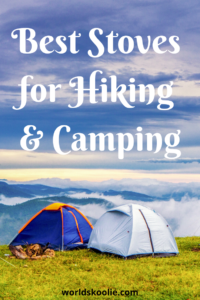
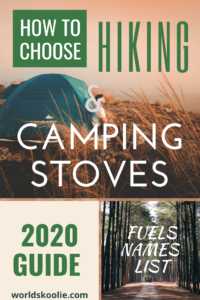
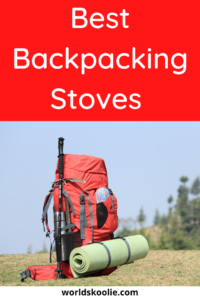
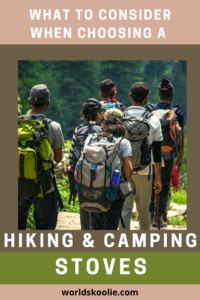
Thanks!

Meagan
Other Useful Items
Butane Fuel Cans |
 |
|
| MSR Liquid Fuel Bottle |
|
|
|
Coghlan’s Fuel Tablets x48 |
 |
|
|
8-Piece Non-Stick Cookware Set |
 |
|
|
Coleman Single-Burner Power-Pack Propane Stove |
|
|
MSR Big Titan |
|
|
|
Titanium Spork |
|
|
|
Victorinox Hiker Pocket Knife |
|

